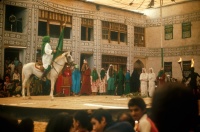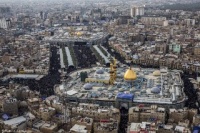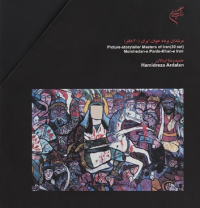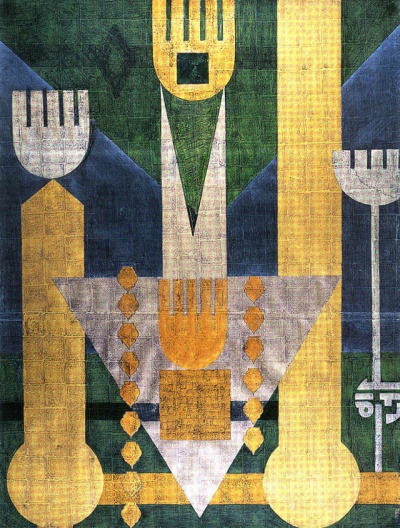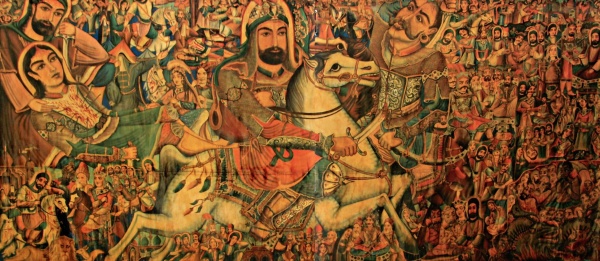- Who was the youngest martyr of Karbala?
- When the Ziarat Arba’een dated back?
- Why Imam Hasan abdicated the Caliphate to Muawiya?
- How many people were killed during Wahhabis’ attack at Karbala?
- In Ta’ziya, who is shown testing and training Ali al-Akbar before the Battle?
- Ashura is considered a day of fasting by Sunnis?
- How many of martyrs of Karbala were descendants of Banu Hashim?
Test: تفاوت میان نسخهها
پرش به ناوبری
پرش به جستجو
جزبدون خلاصۀ ویرایش |
جزبدون خلاصۀ ویرایش |
||
| خط ۱: | خط ۱: | ||
__NOTOC__ | __NOTOC__ | ||
[[en:test]] | [[en:test]] | ||
{{ | {{mainpage/top | ||
mainpage/top | |||
| link 1 = [[ادبیات]] | | link 1 = [[ادبیات]] | ||
| link 2 = جغرافیا | | link 2 = جغرافیا | ||
| خط ۹: | خط ۸: | ||
| link 5 = ادیان و مذاهب | | link 5 = ادیان و مذاهب | ||
| link 6 = علوم اجتماعی | | link 6 = علوم اجتماعی | ||
}}<div class= | }}<div class="first-column-container">{{Featured Index | ||
Featured Index | | image= | ||
| image= | |||
| imagesize = 200px | | imagesize = 200px | ||
| text = [['Ashura]] is the tenth day of Muharram (the first month of the Islamic calendar). It is the climax of the Muharram mourning rituals which commemorates the martyrdom of Hussain ibn Ali, the grandson of the prophet of Islam, Muhammad at the Battle of Karbala on 10 Muharram in the year 61 AH. For Sunnis, it is a day on which fasting is recommended. The root of the word Ashura has the meaning of tenth in Semitic languages. The Arabic term derives from the Hebrew word ʿasor with the Aramaic determinative ending -ā. It refers broadly to the first ten days of Muharram, but more specifically to the tenth day. | | text = [['Ashura]] is the tenth day of Muharram (the first month of the Islamic calendar). It is the climax of the Muharram mourning rituals which commemorates the martyrdom of Hussain ibn Ali, the grandson of the prophet of Islam, Muhammad at the Battle of Karbala on 10 Muharram in the year 61 AH. For Sunnis, it is a day on which fasting is recommended. The root of the word Ashura has the meaning of tenth in Semitic languages. The Arabic term derives from the Hebrew word ʿasor with the Aramaic determinative ending -ā. It refers broadly to the first ten days of Muharram, but more specifically to the tenth day. | ||
| خط ۱۷: | خط ۱۵: | ||
[['Ashura|Full Article...]] | [['Ashura|Full Article...]] | ||
}}{{ | }}{{did you know | ||
did you know | |||
| image =Eternal Performance Taziyeh.jpg | | image =Eternal Performance Taziyeh.jpg | ||
| imagesize = 200px | | imagesize = 200px | ||
| خط ۲۸: | خط ۲۵: | ||
* [http://Shi%CA%BFa#Umayyad_and_Abbasid_Periods Ashura is considered a day of fasting by Sunnis?] | * [http://Shi%CA%BFa#Umayyad_and_Abbasid_Periods Ashura is considered a day of fasting by Sunnis?] | ||
* [[Ziara#Benefits_of_Ziara|How many of martyrs of Karbala were descendants of Banu Hashim?]] | * [[Ziara#Benefits_of_Ziara|How many of martyrs of Karbala were descendants of Banu Hashim?]] | ||
}}</div><div class= | }}</div><div class="second-column-container">{{Featured | ||
Featured | |||
| image =KARBALA.jpg | | image =KARBALA.jpg | ||
| imagesize = 200px | | imagesize = 200px | ||
| خط ۳۸: | خط ۳۴: | ||
* [[Ta'ziya]] | * [[Ta'ziya]] | ||
* [[Ziara]] | * [[Ziara]] | ||
}}{{ | }}{{Works | ||
Works | |||
| image =Picture-storyteller masters of iran.png | | image =Picture-storyteller masters of iran.png | ||
| imagesize = 200px | | imagesize = 200px | ||
| text = The “[[Picture-storyteller Masters of Iran]]” was written by Hamid Reza Ardalan, musician and scholar of ritual arts of Iran, in thirty volumes. This work introduces thirty Pardekhans who are among the remaining generation of picture-storytellers. This book is the result of ten years of library research and field work of the author. Each volume of this series is around 25 picture pages and includes an introduction and analysis of one of the picture-storytellers. The book and CD, as a contribution to preserving ritual arts and oral heritage of Iran, have been published by “Farhagestan-e Honar” in both English and Persian languages. | | text = The “[[Picture-storyteller Masters of Iran]]” was written by Hamid Reza Ardalan, musician and scholar of ritual arts of Iran, in thirty volumes. This work introduces thirty Pardekhans who are among the remaining generation of picture-storytellers. This book is the result of ten years of library research and field work of the author. Each volume of this series is around 25 picture pages and includes an introduction and analysis of one of the picture-storytellers. The book and CD, as a contribution to preserving ritual arts and oral heritage of Iran, have been published by “Farhagestan-e Honar” in both English and Persian languages. | ||
[[Picture-storyteller Masters of Iran|Full Article...]] | [[Picture-storyteller Masters of Iran|Full Article...]] | ||
}}</div>{{ | }}</div>{{CirclePersons | ||
CirclePersons | |||
| image1 = Cloud computing3.JPG | | image1 = Cloud computing3.JPG | ||
| title1 = [[Muslim b. ʿAqil b. Abi Talib|Muslim b. ʿAqil]] | | title1 = [[Muslim b. ʿAqil b. Abi Talib|Muslim b. ʿAqil]] | ||
| خط ۵۶: | خط ۵۰: | ||
| image5 = Cloud computing3.JPG | | image5 = Cloud computing3.JPG | ||
| title5 = [[Fatima]] | | title5 = [[Fatima]] | ||
}}{{ | }}{{Featured art | ||
Featured art | | image = SAQQĀ-ḴĀNA SCHOOL OF ART.jpg | ||
| image = | |||
| imagesize = 400px | | imagesize = 400px | ||
| text = The curtain used by [[Mirza ali khandan|murshed Khandan]], is illustrated by Ostad (acknowledged master) Hossein Hamedani, and dates back more than 50 years. The length of the curtain (Parde) is about 4 metres, and is one of the largest of its kind. The Parde has many faces and gatherings painted upon it. The Darvish curtains are fixed in its generalities but may be varied in details. | | text = The curtain used by [[Mirza ali khandan|murshed Khandan]], is illustrated by Ostad (acknowledged master) Hossein Hamedani, and dates back more than 50 years. The length of the curtain (Parde) is about 4 metres, and is one of the largest of its kind. The Parde has many faces and gatherings painted upon it. The Darvish curtains are fixed in its generalities but may be varied in details. | ||
}}{{ | }}{{Featured art big | ||
Featured art big | |||
| image = Mirza ali khandan 10.jpg | | image = Mirza ali khandan 10.jpg | ||
| imagesize = 600px | | imagesize = 600px | ||
| text = The curtain used by [[Mirza ali khandan|murshed Khandan]], is illustrated by Ostad (acknowledged master) Hossein Hamedani, and dates back more than 50 years. The length of the curtain (Parde) is about 4 metres, and is one of the largest of its kind. The Parde has many faces and gatherings painted upon it. The Darvish curtains are fixed in its generalities but may be varied in details. | | text = The curtain used by [[Mirza ali khandan|murshed Khandan]], is illustrated by Ostad (acknowledged master) Hossein Hamedani, and dates back more than 50 years. The length of the curtain (Parde) is about 4 metres, and is one of the largest of its kind. The Parde has many faces and gatherings painted upon it. The Darvish curtains are fixed in its generalities but may be varied in details. | ||
}}{{ | }}{{Featured indexes | ||
Featured indexes | |||
| main title = Indexes | | main title = Indexes | ||
| column 1 title = Individuals | | column 1 title = Individuals | ||
| خط ۸۴: | خط ۷۵: | ||
| column 5 title =Works | | column 5 title =Works | ||
| column 5 category 1 =Written Works | | column 5 category 1 =Written Works | ||
}}{{ صفحه اصلی/فوتر }} | }}{{صفحه اصلی/فوتر }} | ||
نسخهٔ ۱۶ سپتامبر ۲۰۱۹، ساعت ۱۲:۱۹
به ویکی حسین خوش آمدید
- • ادبیات
- • جغرافیا
- • هنر
- • تاریخ
- • ادیان و مذاهب
- • علوم اجتماعی
مدخل برگزیده
'Ashura is the tenth day of Muharram (the first month of the Islamic calendar). It is the climax of the Muharram mourning rituals which commemorates the martyrdom of Hussain ibn Ali, the grandson of the prophet of Islam, Muhammad at the Battle of Karbala on 10 Muharram in the year 61 AH. For Sunnis, it is a day on which fasting is recommended. The root of the word Ashura has the meaning of tenth in Semitic languages. The Arabic term derives from the Hebrew word ʿasor with the Aramaic determinative ending -ā. It refers broadly to the first ten days of Muharram, but more specifically to the tenth day. Full Article...
آیا میدانستید
اثر برگزیده
The “Picture-storyteller Masters of Iran” was written by Hamid Reza Ardalan, musician and scholar of ritual arts of Iran, in thirty volumes. This work introduces thirty Pardekhans who are among the remaining generation of picture-storytellers. This book is the result of ten years of library research and field work of the author. Each volume of this series is around 25 picture pages and includes an introduction and analysis of one of the picture-storytellers. The book and CD, as a contribution to preserving ritual arts and oral heritage of Iran, have been published by “Farhagestan-e Honar” in both English and Persian languages.
Full Article...
اشخاص
نگاره برگزیده
The curtain used by murshed Khandan, is illustrated by Ostad (acknowledged master) Hossein Hamedani, and dates back more than 50 years. The length of the curtain (Parde) is about 4 metres, and is one of the largest of its kind. The Parde has many faces and gatherings painted upon it. The Darvish curtains are fixed in its generalities but may be varied in details.
نگاره برگزیده
The curtain used by murshed Khandan, is illustrated by Ostad (acknowledged master) Hossein Hamedani, and dates back more than 50 years. The length of the curtain (Parde) is about 4 metres, and is one of the largest of its kind. The Parde has many faces and gatherings painted upon it. The Darvish curtains are fixed in its generalities but may be varied in details.
